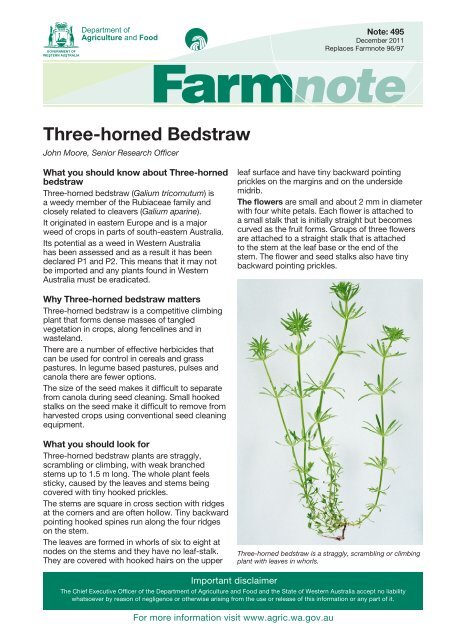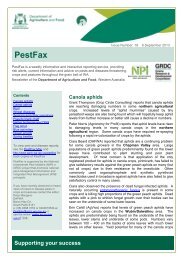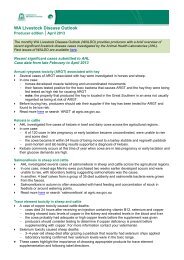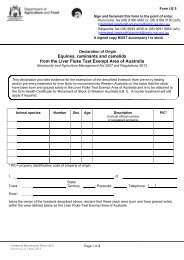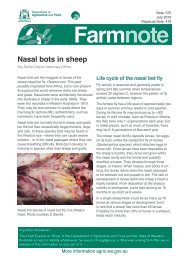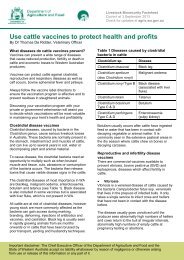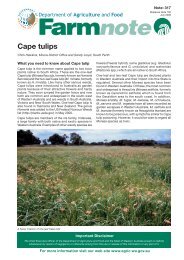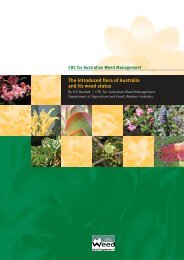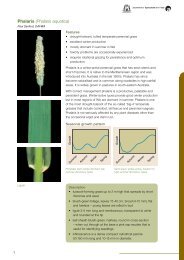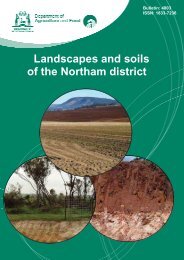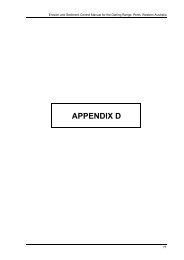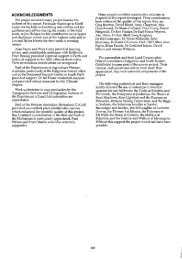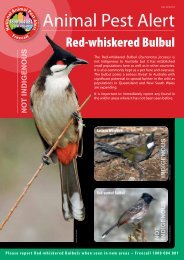Three-horned Bedstraw - Department of Agriculture and Food
Three-horned Bedstraw - Department of Agriculture and Food
Three-horned Bedstraw - Department of Agriculture and Food
Create successful ePaper yourself
Turn your PDF publications into a flip-book with our unique Google optimized e-Paper software.
<strong>Department</strong> <strong>of</strong><br />
<strong>Agriculture</strong> <strong>and</strong> <strong>Food</strong><br />
<strong>Three</strong>-<strong>horned</strong> <strong>Bedstraw</strong><br />
John Moore, Senior Research Officer<br />
What you should know about <strong>Three</strong>-<strong>horned</strong><br />
bedstraw<br />
<strong>Three</strong>-<strong>horned</strong> bedstraw (Galium tricornutum) is<br />
a weedy member <strong>of</strong> the Rubiaceae family <strong>and</strong><br />
closely related to cleavers (Galium aparine).<br />
It originated in eastern Europe <strong>and</strong> is a major<br />
weed <strong>of</strong> crops in parts <strong>of</strong> south-eastern Australia.<br />
Its potential as a weed in Western Australia<br />
has been assessed <strong>and</strong> as a result it has been<br />
declared P1 <strong>and</strong> P2. This means that it may not<br />
be imported <strong>and</strong> any plants found in Western<br />
Australia must be eradicated.<br />
Why <strong>Three</strong>-<strong>horned</strong> bedstraw matters<br />
<strong>Three</strong>-<strong>horned</strong> bedstraw is a competitive climbing<br />
plant that forms dense masses <strong>of</strong> tangled<br />
vegetation in crops, along fencelines <strong>and</strong> in<br />
wastel<strong>and</strong>.<br />
There are a number <strong>of</strong> effective herbicides that<br />
can be used for control in cereals <strong>and</strong> grass<br />
pastures. In legume based pastures, pulses <strong>and</strong><br />
canola there are fewer options.<br />
The size <strong>of</strong> the seed makes it difficult to separate<br />
from canola during seed cleaning. Small hooked<br />
stalks on the seed make it difficult to remove from<br />
harvested crops using conventional seed cleaning<br />
equipment.<br />
What you should look for<br />
<strong>Three</strong>-<strong>horned</strong> bedstraw plants are straggly,<br />
scrambling or climbing, with weak branched<br />
stems up to 1.5 m long. The whole plant feels<br />
sticky, caused by the leaves <strong>and</strong> stems being<br />
covered with tiny hooked prickles.<br />
The stems are square in cross section with ridges<br />
at the corners <strong>and</strong> are <strong>of</strong>ten hollow. Tiny backward<br />
pointing hooked spines run along the four ridges<br />
on the stem.<br />
The leaves are formed in whorls <strong>of</strong> six to eight at<br />
nodes on the stems <strong>and</strong> they have no leaf-stalk.<br />
They are covered with hooked hairs on the upper<br />
Important disclaimer<br />
The Chief Executive Officer <strong>of</strong> the <strong>Department</strong> <strong>of</strong> <strong>Agriculture</strong> <strong>and</strong> <strong>Food</strong> <strong>and</strong> the State <strong>of</strong> Western Australia accept no liability<br />
whatsoever by reason <strong>of</strong> negligence or otherwise arising from the use or release <strong>of</strong> this information or any part <strong>of</strong> it.<br />
For more information visit www.agric.wa.gov.au<br />
Note: 495<br />
December 2011<br />
Replaces Farmnote 96/97<br />
leaf surface <strong>and</strong> have tiny backward pointing<br />
prickles on the margins <strong>and</strong> on the underside<br />
midrib.<br />
The flowers are small <strong>and</strong> about 2 mm in diameter<br />
with four white petals. Each flower is attached to<br />
a small stalk that is initially straight but becomes<br />
curved as the fruit forms. Groups <strong>of</strong> three flowers<br />
are attached to a straight stalk that is attached<br />
0419031_<strong>Bedstraw</strong>_leaf.jpg<br />
to the stem at the leaf base or the end <strong>of</strong> the<br />
stem. The flower <strong>and</strong> seed stalks also have tiny<br />
backward pointing prickles.<br />
<strong>Three</strong>-<strong>horned</strong> bedstraw is a straggly, scrambling or climbing<br />
plant with leaves in whorls.<br />
3233008_<strong>Bedstraw</strong>.jpg
<strong>Three</strong>-<strong>horned</strong> bedstraw leaves are in whorls at the nodes on<br />
the square stems; the white flowers are in groups <strong>of</strong> three,<br />
on curved stalks that also arise from the nodes; leaves,<br />
stems <strong>and</strong> flower stalks are covered with hairs <strong>and</strong> tiny<br />
hooked prickles. (Photo courtesy <strong>of</strong> Michael Moerkerk, DPI<br />
Victoria)<br />
0419031_<strong>Bedstraw</strong>_leaf.jpg<br />
The seeds are formed in pairs <strong>and</strong> each seed is<br />
about the size <strong>of</strong> a canola seed. They are hairless,<br />
but covered with minute warty bumps.<br />
<strong>Three</strong>-<strong>horned</strong> bedstraw closely resembles<br />
cleavers. Cleavers has straight rather than curved<br />
seed stalks <strong>and</strong> has hooked hairs on the seed<br />
rather than tiny, dimply warts.<br />
Why <strong>Three</strong>-<strong>horned</strong> bedstraw might<br />
succeed in Western Australia<br />
<strong>Three</strong>-<strong>horned</strong> bedstraw is an annual plant<br />
germinating in late autumn to early spring. It is<br />
spread by seed. It can be dispersed by wind,<br />
water, on the plant, or by people or animals.<br />
However, in Western Australia, the majority <strong>of</strong><br />
the spread appears to be by movement in grain<br />
or by agricultural machinery <strong>and</strong> particularly by<br />
harvesters.<br />
20112884-09/11-ID10573<br />
Copyright © Western Australian <strong>Agriculture</strong> Authority, 2011<br />
Copies <strong>of</strong> this document are available in alternative formats upon request.<br />
3 Baron-Hay Court South Perth WA 6151<br />
Tel: (08) 9368 3333 Email: enquiries@agric.wa.gov.au Website: www.agric.wa.gov.au<br />
0419032_<strong>Bedstraw</strong>_seed.jpg<br />
Its seeds normally survive in the soil for three to five<br />
years, but can survive longer in non-wetting soils.<br />
<strong>Three</strong>-<strong>horned</strong> bedstraw prefers heavier alkaline<br />
soils, but may grow under less favorable<br />
conditions <strong>and</strong> on other soil types.<br />
_<strong>Bedstraw</strong>_seed.jpg 0419033_<strong>Bedstraw</strong>_seed.jpg<br />
edstraw_seed.jpg 0419033_<strong>Bedstraw</strong>_seed.jpg<br />
<strong>Three</strong>-<strong>horned</strong> bedstraw seeds (natural size in this illustration)<br />
are about the same size as canola seeds, making it difficult<br />
to separate them from canola during seed cleaning. (Photo<br />
courtesy <strong>of</strong> 3233008_<strong>Bedstraw</strong>.jpg<br />
Michael Moerkerk, DPI Victoria)<br />
The seeds <strong>of</strong> <strong>Three</strong>-<strong>horned</strong> bedstraw develop as pairs <strong>of</strong><br />
nutlets that are covered with warty bumps. (Photograph:<br />
Courtesy <strong>of</strong> Michael Moerkerk, DPI Victoria)<br />
What you can do about it<br />
We need to find <strong>and</strong> eradicate any plants <strong>of</strong><br />
<strong>Three</strong>-<strong>horned</strong> bedstraw that exist in Western<br />
Australia. Search suspect paddocks <strong>and</strong> carry out<br />
prescribed control measures.<br />
Where to find out more<br />
For further information on <strong>Three</strong>-<strong>horned</strong> bedstraw,<br />
contact the <strong>Department</strong> <strong>of</strong> <strong>Agriculture</strong> <strong>and</strong> <strong>Food</strong>,<br />
Baron-Hay Court, South Perth 6151. Telephone<br />
1800 084 881 or the nearest country <strong>of</strong>fice <strong>of</strong> the<br />
<strong>Department</strong> <strong>of</strong> <strong>Agriculture</strong> <strong>and</strong> <strong>Food</strong>.<br />
<strong>Three</strong>-<strong>horned</strong> bedstraw flowers.<br />
3233009_<strong>Bedstraw</strong>.jpg<br />
ISSN 0726-934X


